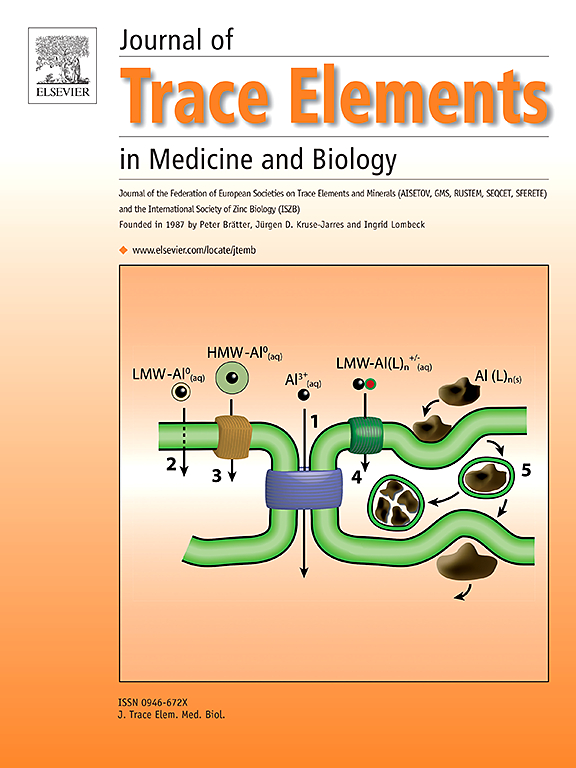Efficacy of ascorbic acid coated quantum dots in alleviating lead-induced oxidative damage and enhancing growth parameters in rice (Oryza sativa L.) for sustainable cultivation
IF 3.6
3区 医学
Q2 BIOCHEMISTRY & MOLECULAR BIOLOGY
Journal of Trace Elements in Medicine and Biology
Pub Date : 2025-01-20
DOI:10.1016/j.jtemb.2025.127603
引用次数: 0
Abstract
Lead (Pb) toxicity impairs the growth, yield, and biochemical traits of rice, making it essential to mitigate Pb stress in soil and restore its growth and production. This study investigated the potential of ascorbic acid-coated quantum dots (AsA-QDs) in alleviating Pb stress in two rice cultivars, Japonica (JP-5) and Indica (Super Basmati), grown in pots under Pb stress (50 mg/kg as lead chloride) with AsA-QD suspensions (50 ppm and 100 ppm) as treatments. The synthesized AsA-QDs were characterized by zeta potential (-14.4 mV), particle size (472.3 nm, PDI 0.745), UV-Vis absorption peak (240 nm), FT-IR analysis revealing functional groups (carboxylic acid and alkene), and TEM showing spherical morphology (average size 9.43 nm). Pb stress reduced key traits in JP-5, including tillers per plant (11.11 %), grain yield (18.22 %), kernel weight (18.22 %), protein (40.19 %), phenolic content (59.66 %), and antioxidant capacity (17.75 %), while 50 ppm AsA-QDs improved these by 33.33 %, 5.73 %, 2.03 %, and 13.19 %, respectively. Similarly, Pb stress reduced plant height, T/P, biomass yield (BY), GY, TKW, total sugars, reducing sugars, non-reducing sugars, starch, proteins, and TPC in Super Basmati by 19.76 %, 21.43 %, 11.01 %, 11.01 %, 7.52 %, 38.09 %, 7.24 %, 13.96 %, 11.97 %, and 40.39 %, respectively, while PbQD1 improved these traits by 14.29 %, 15.49 %, 9.25 %, 109.52 %, 8.31 %, 31.72 %, 25.91 %, and 7.075 %, respectively. The findings demonstrate that AsA-QDs effectively mitigate Pb toxicity by reducing oxidative stress, enhancing growth parameters, and restoring yield components, establishing them as a promising nanomaterial for sustainable crop resilience under Pb stress.
抗坏血酸包被量子点减轻铅诱导的氧化损伤和提高水稻生长参数对可持续栽培的影响
铅中毒对水稻的生长、产量和生化性状均有影响,因此减轻土壤铅胁迫,恢复水稻的生长和生产至关重要。研究了抗坏血酸包被量子点(AsA-QDs)对两种水稻品种Japonica (JP-5)和Indica (Super Basmati)在Pb(50 mg/kg氯化铅)胁迫下,以AsA-QD悬浮液(50 ppm和100 ppm)为处理剂,在盆栽条件下缓解Pb胁迫的潜力。通过zeta电位(-14.4 mV)、粒径(472.3 nm, PDI 0.745)、UV-Vis吸收峰(240 nm)、FT-IR分析显示官能团(羧酸和烯烃),TEM显示球形形貌(平均尺寸9.43 nm)对合成的AsA-QDs进行了表征。JP-5 Pb压力减少关键特征,包括单株分蘖(11.11 %),粮食产量(18.22 %),粒重(18.22 %)、蛋白质(40.19 %),酚醛含量(59.66 %),和抗氧化能力(17.75 %),而50 ppm AsA-QDs改善这些33.33 %,5.73 % 2.03 %,分别和13.19 %。同样,Pb压力降低株高,T / P,生物质产量(通过),GY, TKW,总糖、还原糖、非还糖,淀粉,蛋白质,和TPC超级印度香米 % 19.76,21.43 % 11.01 % 11.01 % 7.52 % 38.09 % 7.24 % 13.96 %, % 11.97和40.39 %,分别虽然PbQD1 %这些特征提高了14.29,15.49 % 9.25 % 109.52 % 8.31 % 31.72 % 25.91 %,分别和7.075 %。研究结果表明,AsA-QDs通过降低氧化胁迫、提高生长参数和恢复产量组分,有效减轻铅毒性,是一种有前景的Pb胁迫下作物可持续抗逆性纳米材料。
本文章由计算机程序翻译,如有差异,请以英文原文为准。
求助全文
约1分钟内获得全文
求助全文
来源期刊
CiteScore
6.60
自引率
2.90%
发文量
202
审稿时长
85 days
期刊介绍:
The journal provides the reader with a thorough description of theoretical and applied aspects of trace elements in medicine and biology and is devoted to the advancement of scientific knowledge about trace elements and trace element species. Trace elements play essential roles in the maintenance of physiological processes. During the last decades there has been a great deal of scientific investigation about the function and binding of trace elements. The Journal of Trace Elements in Medicine and Biology focuses on the description and dissemination of scientific results concerning the role of trace elements with respect to their mode of action in health and disease and nutritional importance. Progress in the knowledge of the biological role of trace elements depends, however, on advances in trace elements chemistry. Thus the Journal of Trace Elements in Medicine and Biology will include only those papers that base their results on proven analytical methods.
Also, we only publish those articles in which the quality assurance regarding the execution of experiments and achievement of results is guaranteed.

 求助内容:
求助内容: 应助结果提醒方式:
应助结果提醒方式:


